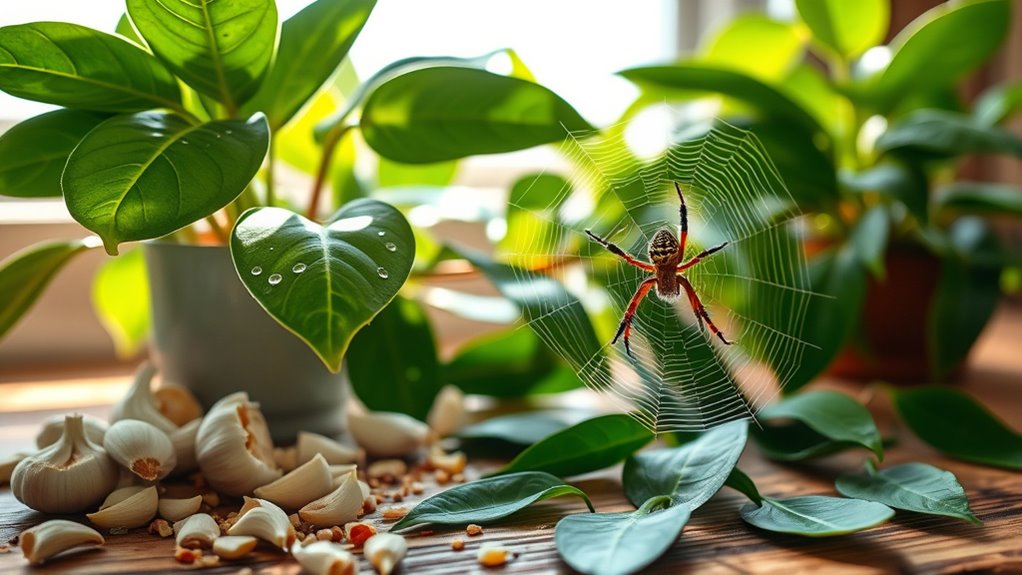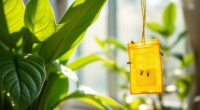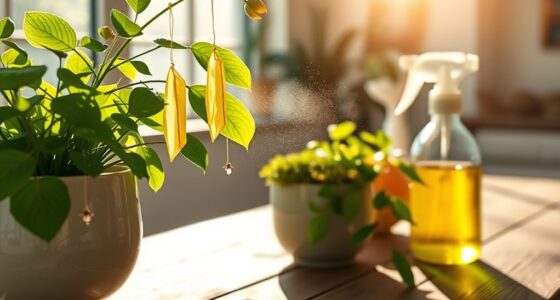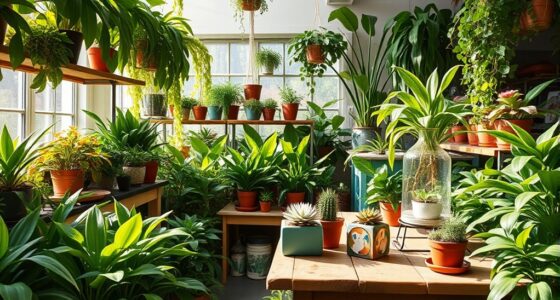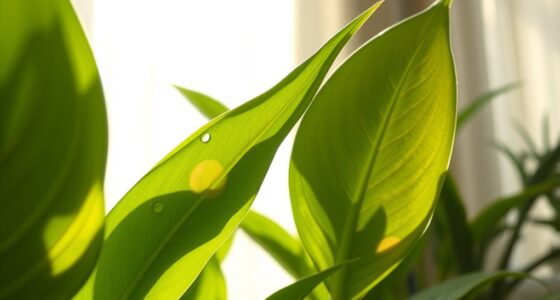To get rid of bugs on your indoor plants naturally, start by identifying common pests like aphids and mealybugs. Use solutions like soap and water, neem oil, or essential oils to combat these nuisances. Create homemade sprays with garlic or chili pepper to deter intruders. Prevent infestations by checking moisture levels and ensuring good air circulation. Regular monitoring and upkeep can keep your plants healthy. There’s more to discover about effective strategies for keeping pests at bay!
Key Takeaways
- Use a soap and water solution or neem oil to effectively target common pests like aphids and mealybugs.
- Create a garlic and chili pepper spray to deter a variety of insects naturally.
- Ensure proper watering and maintain dry soil to disrupt pest life cycles and reduce infestations.
- Incorporate pest-repellent plants around your indoor garden to enhance natural pest management.
- Regularly inspect and monitor your plants for early signs of pests to catch infestations quickly.
Understanding Common Indoor Plant Pests
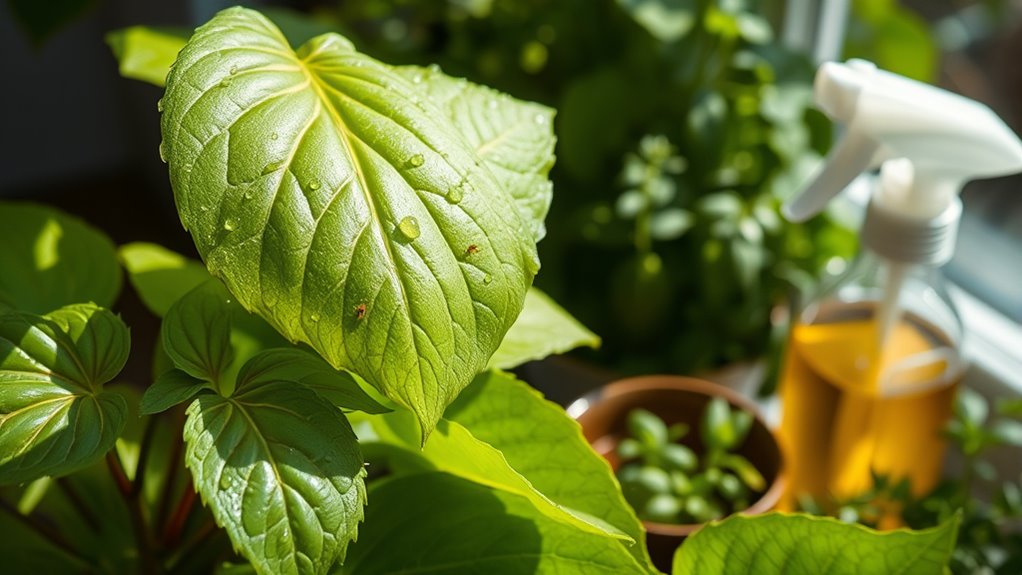
Indoor plants can be a source of joy, but they often attract pesky pests that threaten their health. Understanding these common indoor plant pests is crucial for maintaining your greenery.
Aphids, small and pear-shaped, suck sap and cause yellowing leaves. Controlling insects through prevention is easier than elimination, so keeping an eye on your plants can help prevent these pests from becoming a problem. Sustainable fashion practices indicate that using eco-friendly pest control methods can also benefit your indoor environment. Additionally, diversification in your plant choices can help create a more resilient indoor garden that is less susceptible to pest infestations. Effective relaxation techniques can also help you manage the stress that comes with pest problems.
Fungus gnats, weak fliers, lay eggs in moist soil, harming roots with their larvae.
Leafminers create unsightly trails as they feed between leaf surfaces.
Mealybugs, with their fluffy white appearance, lead to stunted growth and sticky residue.
Scale insects, covered in wax, sap your plant’s vitality and promote sooty mold.
Identifying these pests early helps you take action before they cause serious damage, ensuring your plants thrive in your indoor oasis.
Natural Pest Control Methods
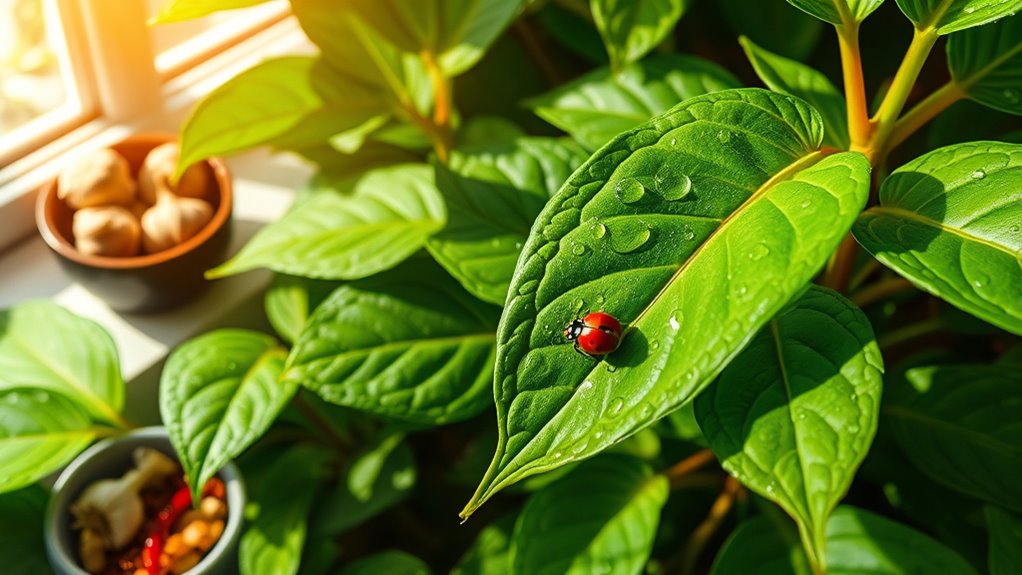
When pests invade your plants, natural pest control methods offer effective solutions without harsh chemicals. One simple approach is using a soap and water solution, which can tackle various pests. Neem oil is another powerful option, effective against aphids, whiteflies, and mealybugs. Additionally, regular monitoring of your plants helps catch infestations early and ensures timely intervention. It’s also important to consider the soil moisture check to prevent overwatering, as excess water can attract pests. Incorporating probiotics for plants can also promote a healthier environment, making them less susceptible to infestations. Using self-watering pots can help maintain ideal moisture levels, thus reducing the chances of pest attraction.
For crawling insects like ants and slugs, try diatomaceous earth, a natural powder that dehydrates them. You can also use a cotton swab dipped in alcohol or oil to manually remove mealybugs and scale. If you’re dealing with fungus gnats, a hydrogen peroxide soil drench will eliminate their larvae.
Creating Homemade Pest Sprays
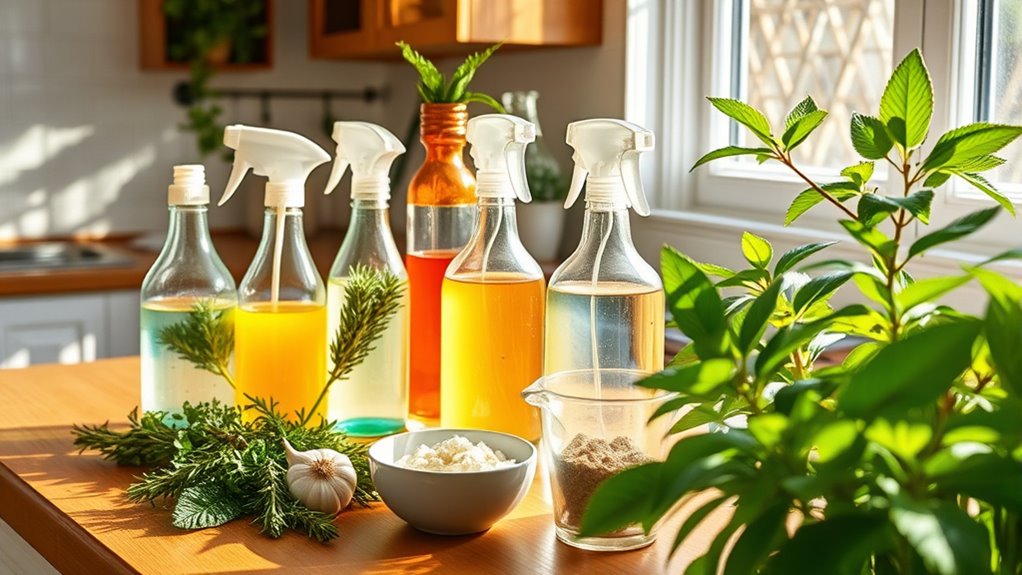
Creating homemade pest sprays is an effective way to protect your plants from unwanted intruders.
You can start with insecticidal soap sprays by mixing vegetable oil with dishwashing soap to create a concentrate. Dilute this with water to combat aphids and mealybugs, but avoid soaps with degreasers or bleach. Additionally, using insecticidal soap can effectively target pests like lace bugs and leafhoppers. Many essential oils, such as lavender, also provide natural pest-repelling properties. This approach can be enhanced by knowing that antioxidants found in certain natural ingredients can also provide protective benefits, especially when combined with HEPA filters for overall indoor air quality.
For a more aromatic approach, combine essential oils like citronella and eucalyptus with water and witch hazel to repel mosquitoes. Boiling rosemary in water also creates a deterrent for various pests.
If you need something stronger, blend garlic and chili peppers, steep, and strain for a potent spray.
Always remember to test any new spray on a small area before applying it broadly to your plants.
Preventive Measures to Avoid Infestations
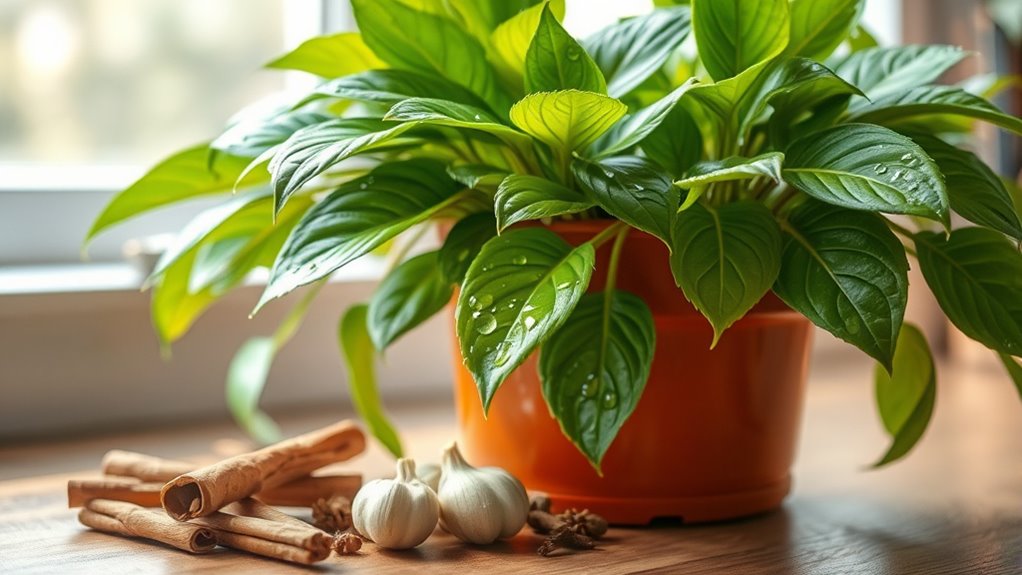
To keep your plants thriving and pest-free, proactive measures are essential. Start by ensuring proper watering; overwatering can lead to moist soil that attracts pests. Additionally, maintaining dry soil helps disrupt the lifecycle of pests and reduces their presence. A diet rich in antioxidants like quercetin can also help strengthen your plants’ defenses against pests. Incorporating natural materials like wood and stone can enhance the overall health of your plants by providing a more organic growing environment.
Maintain good air circulation and humidity levels between 40-60% to create a healthy environment. Provide sufficient light to strengthen your plants against infestations. Always use well-draining soil and check for stagnant water in pots.
Before introducing new plants, inspect them for pests and quarantine them for 2-4 weeks. Regularly check existing plants for signs of pests and isolate any infested ones.
Consider using sticky traps for flying pests and apply soil barriers to deter nesting. These simple steps can significantly reduce the risk of pest infestations in your indoor garden.
Using Commercial Natural Pest Control Options
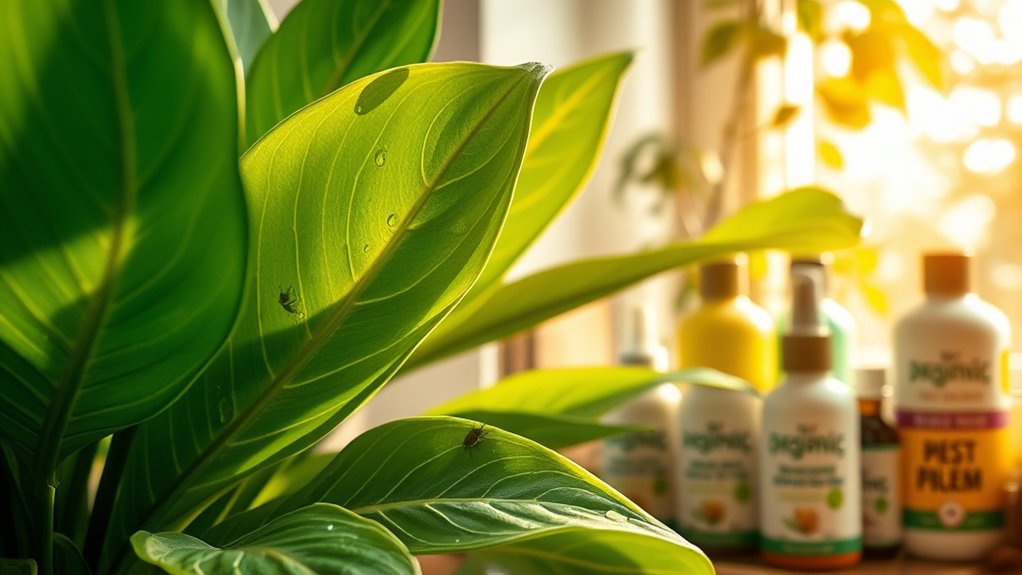
While many indoor gardeners rely on homemade solutions, using commercial natural pest control options can provide a more effective and convenient way to manage pests.
Products like Protection Plus™ natural insecticide spray effectively target russet mites, aphids, and more without harming your plants. These eco-friendly formulations ensure safety for the environment and reduce residue buildup. Additionally, they meet regulatory standards through rigorous safety testing, ensuring you are using a reliable product. The application process often benefits from color accuracy, enhancing the visibility of pests on your plants for better targeting. By choosing these products, you can experience the love and compassion that nature embodies in your gardening journey. Furthermore, utilizing proper planning in pest control can help you avoid costly mistakes that harm your plants.
Protection Plus™ natural insecticide spray effectively controls pests like russet mites and aphids while keeping your plants safe and the environment clean.
You can apply them in various ways, from soil treatments to hydroponic systems, enhancing versatility. Additionally, they often save you money over time by minimizing the need for frequent applications.
With rigorous safety testing and compliance with regulatory standards, you can trust these products to keep your indoor plants healthy and pest-free.
Embrace this simple, effective approach for thriving plants!
Environmental Considerations for Pest Control
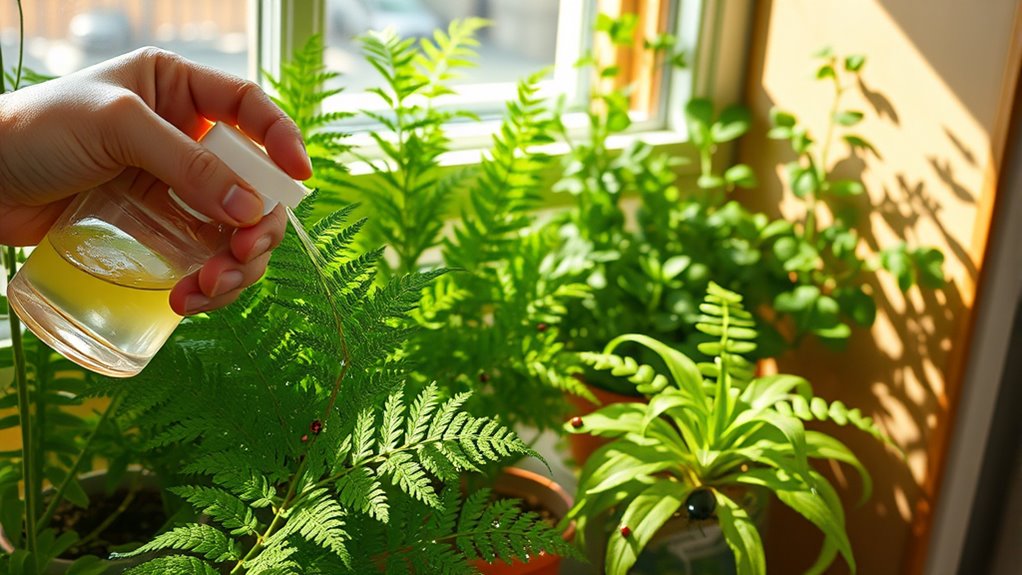
When managing pests on indoor plants, it’s essential to consider the environmental impact of your methods. Many indoor plants attract pests due to their fragrant and sugary leaves, which serve as a food source. Your home, lacking natural predators, creates a perfect environment for these pests to thrive. To prevent infestations, regularly monitor your plants and quarantine new additions. By opting for natural pest control methods, you reduce reliance on harmful chemical pesticides, promoting a healthier indoor environment. Not only do these methods protect your plants, but they also safeguard your family and pets from toxicity. Incorporating pest-repellent plants into your home can further enhance your efforts in maintaining a pest-free indoor garden. Additionally, using solar-powered solutions for indoor gardening can help create a sustainable environment by reducing energy consumption. Embracing sustainable practices enhances air quality and maintains ecological balance, ultimately benefiting both you and your indoor garden. This approach aligns with self-care routines that prioritize well-being, fostering a harmonious living space.
Tips for Maintaining Healthy Indoor Plants
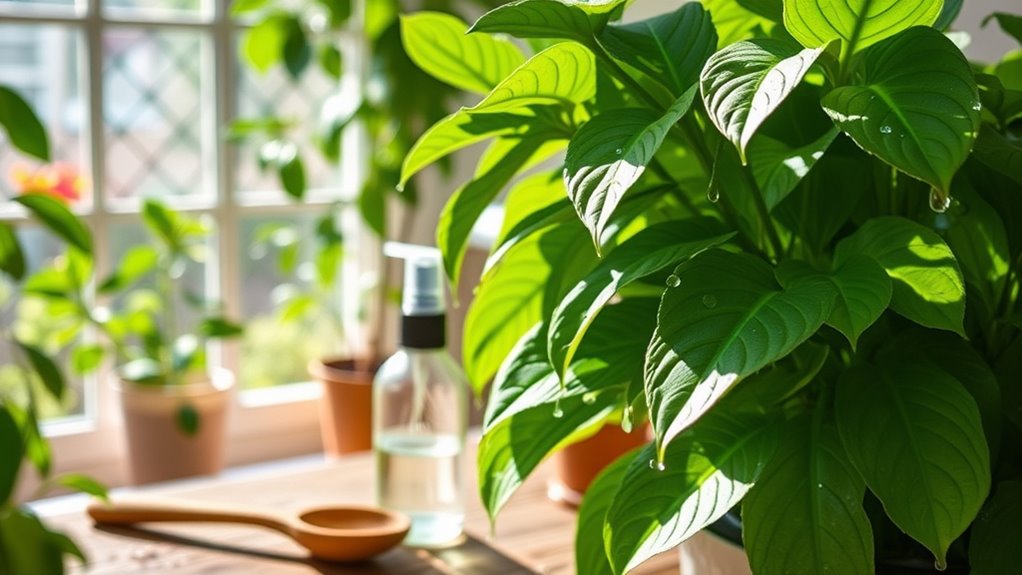
Maintaining healthy indoor plants is essential for creating a vibrant living space and ensuring your greenery thrives.
Start by choosing low-maintenance plants like succulents or snake plants that fit your busy lifestyle. Pay attention to your plants’ lighting and humidity needs, and adjust your care schedule accordingly. Choose plants based on light to ensure they receive the appropriate amount of sunlight for optimal growth. Additionally, practicing mindful consumption when selecting your plants can lead to a more sustainable and satisfying gardening experience. It’s also important to provide ample space for your plants to grow, as overcrowding can lead to stress and health issues.
Water only when the soil is dry, using warm water for better absorption, and ensure your planters have drainage holes to prevent root rot. During growth seasons, fertilize to promote healthy development, but avoid this in winter when plants rest. Regular monitoring for pests can help catch any infestations early.
Regularly inspect for pests, quarantine infested plants, and use simple home remedies for control.
Lastly, don’t forget to prune and clean your plants to keep them healthy and thriving.
Frequently Asked Questions
How Can I Identify Specific Pests on My Indoor Plants?
To identify specific pests on your indoor plants, start by closely inspecting the leaves and stems.
Look for signs like sticky honeydew, webbing, or unusual spots. Check for small, pear-shaped insects like aphids, or tiny, red spider mites.
If you see fluffy white clusters, you might’ve mealybugs. Pay attention to fast-moving thrips by spotting silvery streaks.
Regular monitoring helps catch infestations early, ensuring your plants stay healthy and thriving.
What Are the Signs of a Severe Infestation?
You walk into your room and notice your beloved plant looking sickly.
Leaves are yellowing and curling, with fine webs creeping across the stems. As you inspect closer, you find sticky residue coating the leaves, a sure sign something’s wrong.
You can even spot clusters of small pests. This isn’t just a little issue; it’s a severe infestation that’s causing your plant to decline rapidly.
Time to act before it’s too late!
Are Certain Plants More Susceptible to Pests?
Yes, certain plants are indeed more susceptible to pests. For instance, tropical plants often struggle in indoor conditions, making them vulnerable.
You’ll find that Norfolk Island Pines and Ivies attract spider mites, while Crotons can also face various pests.
Stress factors like overwatering or nutrient deficiencies increase susceptibility. By understanding your plants’ needs, you can help reduce their risk and keep them healthier, making them less appealing to pests.
Can Indoor Pets Get Affected by Plant Pests?
When your plants invite little critters to the party, it’s not just the greenery getting a surprise.
Your indoor pets can also feel the effects. They might encounter pests through curious sniffs or by nibbling on infested leaves.
These bugs can make your plants weak, and if your pet ingests any contaminated parts, it could lead to tummy troubles.
Keeping a watchful eye on both your plants and pets helps everyone stay safe and sound.
How Often Should I Apply Natural Pest Control Methods?
You should apply natural pest control methods as soon as you notice pests.
For severe infestations, treat every few days, while lighter ones might only need weekly applications.
Keep an eye on environmental factors like temperature and humidity, adjusting your schedule as needed.
Regularly inspect your plants to determine if more treatments are necessary, ensuring you stay proactive in managing any potential pest issues before they escalate.
Conclusion
By understanding common pests, using natural control methods, and creating homemade sprays, you can protect your indoor plants effectively. By keeping your plants healthy, maintaining a clean environment, and using preventive measures, you can enjoy thriving greenery. Remember, healthy plants are resilient plants, and resilient plants resist pests. So, take action today, stay vigilant, and nurture your indoor garden naturally. Your plants will flourish, and you’ll feel accomplished in your pest management journey.

